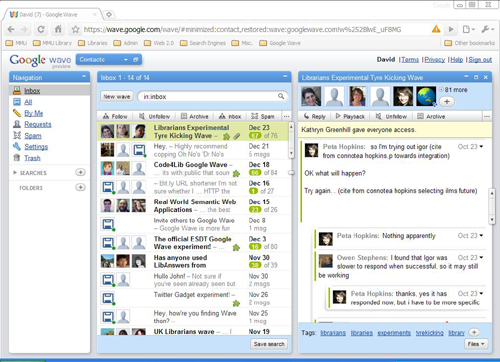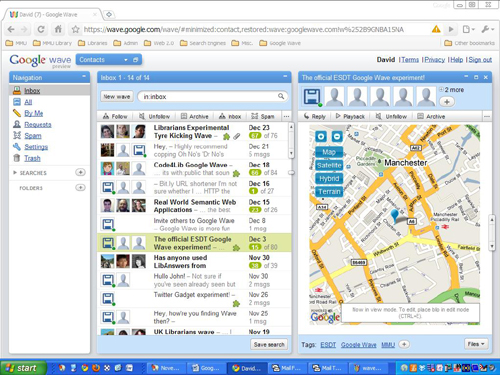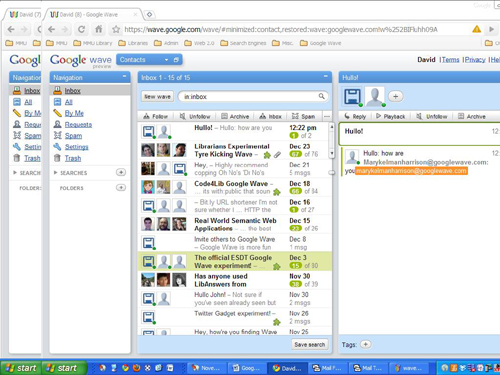Google Wave and libraries: a snapshot
Posted by guestblogger on 4th January 2010
On the 16th November last year David Jenkins, Assistant Librarian in the Electronic Resources Development Team at Manchester Metropolitan University, posted an email to the LIS-WEB2 mailing list asking about Google Wave usage among librarians. David has been kind enough to summarise his findings for us in a guest blog post.
David can be reached by email (d.jenkins@mmu.ac.uk), on Twitter @d_jenkins or on Wave (jenkins.david.r@googlewave.com).
*****************
The questions I asked the LIS-WEB2 mailing list were:
• If anybody else in the library world was using Google Wave?
• If so, what for and how?
• Do you have any library-related waves or Wave resources to recommend?
The opinions and information I was sent in response provided an interesting look at how Google Wave is being used by librarians and how it could be used by them in the future.
For an introduction to Wave itself see Google Wave: What’s all the Fuss About?. Readers can also refer to the Resources list at the end of this post for other recommended introductions to Wave and, if possible, actually use Wave themselves in order to become familiar with it.
One of the first things I got an insight into from the reaction to my questions was the popularity of Wave with librarians. I received over 20 responses in less than two days, which suggested a high level of interest in Wave. Indeed, as Google Wave accounts are available by invite only, a number of people were enquiring about invites to the service and a page was set up on the SINTO wiki to facilitate such requests. I was informed that there are numerous waves started by librarians and focusing upon library issues (please see the Library-related waves section of Resources below). Upon using Wave myself and reading around the topic, the impression I got is that the level of engagement with and interest in Wave amongst librarians appears to be proportionate to its popularity with the general public.

This enthusiasm for Wave was reflected in the behaviour of the existing library community that use the service. There seemed to be a general willingness amongst librarians to share Wave resources and knowledge. People were outgoing; adding me as a contact, inviting me to waves, putting me in touch with other Wave users and sending Wave invites to other librarians who requested them.

However, in spite of the apparent popularity of Wave, I received only two ideas regarding how Wave might be used in a library context. One respondent stated they had considered using Wave for collaborating with fellow members of an online study group. The group makes electronic and hard copy magazines, runs a blog and collaborates on various other creative projects and Wave offers them the ability to create and discuss their material online. Another respondent expressed a more general interest in the potential of Wave, putting forward the possibility of integrating Wave with Talis Prism 3 via the Juice Project. These ideas give something of a general impression of the variety of potential applications for Wave in libraries. The fact so few ideas were submitted is indicative of the fact the Wave is still at an early stage of its development and is only available to a limited (if rapidly growing) pool of users. It will take time and effort to establish what Wave is capable of and how those capabilities can best be exploited by libraries.

Security concerns about Wave were raised and it seemed that a number of organisations’ ICT departments have reservations about the service. For example, Wave gadgets are applications that operate in Wave, allowing the embedding of code from non-trusted sources. As a result they are potentially vulnerable to cross-site scripting (XSS) threats. Google’s own Yes/No/Maybe gadget triggers a clickjacking warning when using NoScript because the gadget contains partially hidden elements. While not necessarily an issue in itself when the gadget in question is provided by a trusted source it does highlight the fact that a non-trusted source could create a gadget with hidden elements in order to pose a clickjacking threat to Wave users. For a general overview of security issues in Wave see Social Hacking.
Two more respondents highlighted their worries regarding privacy in Wave. It was of concern that, if another user has your username, they can add you as a contact, whether you like it or not. Not only that but, once another user has added you as a contact, they can then add you to a wave, whether you like it or not too. This lack of control over your own account deterred these respondents from using Wave at all.

Access to Wave was an issue for public library workers. Respondents reported that many councils block Wave on staff computers, meaning many public librarians cannot access the program in order to figure out how it could be used in their environment.
Overall, whilst interest in Wave was high, there was a degree of scepticism regarding how useful it is to librarians. Tellingly, some respondents felt that there are not enough extensions for Wave to make it useful to librarians yet and that nobody has actually found a valuable practical use for Wave in libraries at this point. One respondent went as far as to state that Wave has yet to be used for anything beyond time wasting. On the whole, respondents seemed happy to let Wave develop and let other people find uses for it before they approach it with any seriousness.
I would like to extend my thanks to everybody on the LIS-WEB2 list who took the time to respond to my questions and to John Whalley (Senior Assistant Librarian – Manchester Metropolitan University) for information and advice regarding security in Google Wave .
Resources
Introductions
- The Complete Guide to Google Wave: How to Use Google Wave a free ebook:
http://completewaveguide.com/ - What is Google Wave? video:
http://www.youtube.com/watch?v=rDu2A3WzQpo - Google Wave: A Complete Guide:
http://mashable.com/2009/05/28/google-wave-guide/ - 7 Things You Should Know About…Google Wave:
http://net.educause.edu/ir/library/pdf/ELI7055.pdf
Invites
- A page on the SINTO wiki for librarians who are looking for a Google Wave invitation. People who have invitations and are looking for recipients can check this page and send out invites:
http://sinto.wetpaint.com/page/Google+Wave
Library-related public waves
N.B. You will need to be able to log into an active Google Wave account to view these waves.
- UK librarian’s wave:
https://wave.google.com/wave/#restored:wave:googlewave.com!w%252Bh3Tm9k-aB - Librarians Experimental Tyre Kicking Wave:
https://wave.google.com/wave/#restored:wave:googlewave.com!w%252BlwE_uF8MG - Code4Lib Google Wave:
https://wave.google.com/wave/#restored:wave:googlewave.com!w%252B3y5N1Y8uA.1 - A Google Wave search for with:public librarians, which will return all publicly accessible waves featuring the keyword librarians:
https://wave.google.com/wave/#restored:search:with%253Apublic+librarians,restored:wave:googlewave.com!w%252BU-GZQ11wW
Library-related bots
- Milton (uncle-milty@appspot.com) – when you type a single word in a blip, Milton returns a list of titles from the John Hopkins University catalogue relating to that keyword
- Fnordlinky (fnordlinks@appspot.com) – enter a PMID into a blip e.g. “PMID 12748199” and Fnordlinky replaces it with the citation information from PubMed
- Library-y (library-y@appspot.com) – enter an ISBN into a blip e.g. 1606992864 and Library-y turns it into a link to the Library Thing entry for that title
- Igor (helpmeigor@appspot.com) – reference management
Tags: googlewave
Posted in Guest-blog, Libraries | 4 Comments »

